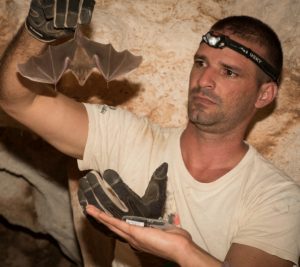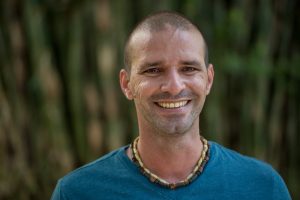Jose de la Cruz Mora is one of our newest EDGE Fellows, who will soon be starting his project focused on the Cuban greater funnel-eared bat in Cuba. We asked Jose to write this blog to introduce himself, his project, and explain what an EDGE Fellowship means to him.
The Funnel-Eared Bat Natalus primus was described as extinct once… I think that one time is enough! Don’t you?

Since I was small I have been attracted to the fauna around me – long days passed looking and playing with animals as much as they would allow me to. Years later I supported the research of Emanuel C. Mora, an outstanding investigator in the field of the bats (and also my uncle!) and this experience made me fall in love with bats from a very early age.
After graduating from university as a biologist specializing in the ecology of Cuban bats, I began work in the Museum of Natural History and in Guanahacabibes and Viñales National Parks. That was when I really learned about of the level of threat faced by many of the species of bats in this region. Our work in the museum and in the national parks allowed us to strengthen the ex situ and in situ conservation efforts of threatened bats species and the habitats where they live.
These last few years working with bats in the west of Cuba have been intense, and the most common places we work have always been the caverns – where the work conditions are always difficult, but very fun! Luckily for me, I have been able to get help from a great team of colleagues from around the world, people interested in the protection of free living species and who aren’t afraid of getting their hands dirty to get the job done!
Natalus primus; one of the most endangered species in Cuba
The Natalidae family of bats have been evolving in isolation from other bats for around 50 million years, and therefore represent a disproportionately large share of mammalian evolutionary history. Within the natalids, the genus Natalus has been reported as extinct from seven islands, and has undergone more extirpation events than any of the two other West Indian Natalid genera (Nictyellus and Chilonatalus).
The rarest and most threatened Natalid species is Natalus primus, the Cuban greater funnel-eared bat. Natalus primus, was first discovered as a fossil in eastern Cuba and later in 13 other fossil localities throughout Cuba and Isla de Pinos. Once thought to be extinct, it was rediscovered in 1992 in a remote cave – Cueva La Barca in Guanahacabibes, far western Cuba.
The species is threatened by its small population size (the actual population size remains unknown), its existence in just one location (which is vulnerable, e.g. to hurricanes or disturbance), and potential changes to its foraging habitat (such as selective logging). Since it is so rare, very little is known about its life-history, reproductive cycle, and habitat requirements making it difficult to establish an efficient conservation plan for the species. For my EDGE Fellowship project, I will be studying this fascinating bat species – the Cuban greater funnel-eared bat. My two main goals: First, to gather the necessary ecological information (current status, habitat use, reproductive cycle and others) to assess its current conservation status and habitat requirements. Second, to use this information to support the education mission of the Guanahacabibes National Park and the Natural History Museum of Pinar del Río.
Read more about the Cuban greater funnel-eared bat here and about Jose here.

Jose de la Cruz Mora is a biologist, specializing in Cuba’s bat ecology and conservation. A graduate of Havana University, he is a full time researcher at the Museum of Natural History of Pinar del Rio Province. He participated in various research projects at national and international levels. He has also contributed to several conferences in Cuba and outside the country and was awarded five Academy Primes granted by the Academy Science of Cuba. He is a member of the Program for The Conservation of Bats in Latin America, the Cuban Zoological Society and the EDGE fellowship program, supported by the Zoological Society of London and Fondation Segré.

